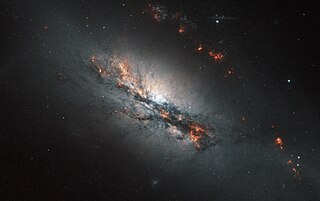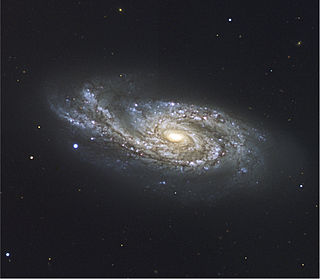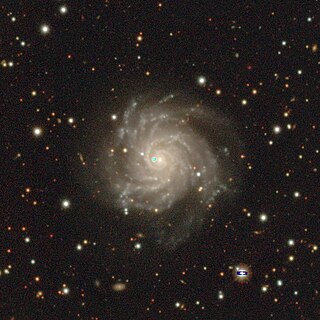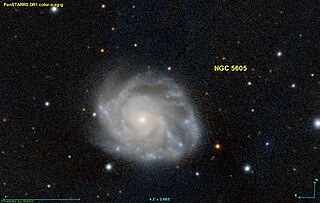
Messier 83 or M83, also known as the Southern Pinwheel Galaxy and NGC 5236, is a barred spiral galaxy approximately 15 million light-years away in the constellation borders of Hydra and Centaurus. Nicolas-Louis de Lacaille discovered M83 on 17 February 1752 at the Cape of Good Hope. Charles Messier added it to his catalogue of nebulous objects in March 1781.

Messier 61 is an intermediate barred spiral galaxy in the Virgo Cluster of galaxies. It was first discovered by Barnaba Oriani on May 5, 1779, six days before Charles Messier discovered the same galaxy. Messier had observed it on the same night as Oriani but had mistaken it for a comet. Its distance has been estimated to be 45.61 million light years from the Milky Way Galaxy. It is a member of the M61 Group of galaxies, which is a member of the Virgo II Groups, a series of galaxies and galaxy clusters strung out from the southern edge of the Virgo Supercluster.

NGC 4088 is an intermediate spiral galaxy in the constellation Ursa Major. The galaxy forms a physical pair with NGC 4085, which is located 11′ away.

NGC 6744 is an intermediate spiral galaxy in the constellation Pavo (Peacock). Its velocity with respect to the cosmic microwave background is 802 ± 3 km/s, which corresponds to a Hubble distance of 38.6 ± 2.7 Mly (11.82 ± 0.83 Mpc). However, 21 non redshift measurements give a distance of 23.63 ± 1.68 Mly (7.244 ± 0.514 Mpc). It was discovered on 30 June 1826 by Scottish astronomer James Dunlop, observing from Parramatta, Australia.

NGC 2207 and IC 2163 are a pair of colliding spiral galaxies about 80 million light-years away in the constellation Canis Major. Both galaxies were discovered by John Herschel in 1835.

NGC 5253 is an irregular galaxy in the constellation Centaurus. It was discovered by William Herschel on 15 March 1787.

NGC 3938 is an unbarred spiral galaxy in the Ursa Major constellation. It was discovered on 6 February 1788 by William Herschel. It is one of the brightest spiral galaxies in the Ursa Major South galaxy group and is roughly 67,000 light years in diameter. It is approximately 43 million light years away from Earth. NGC 3938 is classified as type Sc under the Hubble sequence, a loosely wound spiral galaxy with a smaller and dimmer bulge. The spiral arms of the galaxy contain many areas of ionized atomic hydrogen gas, more so towards the center.

NGC 2146 is a barred spiral galaxy type SB(s)ab pec in the constellation Camelopardalis. The galaxy was discovered in 1876 by Friedrich August Theodor Winnecke.

NGC 4527 is a spiral galaxy in the constellation Virgo. It is a member of the M61 Group of galaxies, which is a member of the Virgo II Groups, a series of galaxies and galaxy clusters strung out from the southern edge of the Virgo Supercluster.

NGC 6181 is a barred spiral galaxy located in the constellation Hercules. It is designated as SB(rs)c in the galaxy morphological classification scheme and was discovered by William Herschel on 28 April 1788. The galaxy is 107 million light years away.

NGC 908 is an unbarred spiral galaxy in the constellation Cetus. It was discovered on 20 September 1786 by William Herschel. This galaxy is 56 million light years away from Earth. It is the main galaxy in the NGC 908 group, which also includes NGC 899, NGC 907, and IC 223.

NGC 132 is a spiral galaxy in the constellation Cetus. Its velocity with respect to the cosmic microwave background is 5015 ± 25 km/s, which corresponds to a Hubble distance of 241.3 ± 16.9 Mly (73.97 ± 5.19 Mpc). In addition, three non redshift measurements give a distance of 250.81 ± 2.14 Mly (76.900 ± 0.656 Mpc). It was discovered on 25 December 1790 by German-British astronomer William Herschel.

NGC 5468 is an intermediate spiral galaxy located in the constellation Virgo. It is located at a distance of about 140 million light-years from Earth, which, given its apparent dimensions, means that NGC 5468 is about 110,000 light-years across. It was discovered by William Herschel on March 5, 1785.

NGC 3646 is a galaxy in the Leo constellation that has variously been described as "a strange spiral galaxy" of morphological classication Sc or SAa, or as "a ring-shaped galaxy". It was discovered by German-British astronomer William Herschel on 15 February 1784.

NGC 4375 is a barred spiral galaxy in the constellation of Coma Berenices. Its velocity with respect to the cosmic microwave background is 9325 ± 20 km/s, which corresponds to a Hubble distance of 137.54 ± 9.63 Mpc. However, four non-redshift measurements give a distance of 105.5 Mpc. The galaxy was discovered by German-British astronomer William Herschel on 11 April 1785.

NGC 2466 is a spiral galaxy in the constellation of Volans. Its velocity with respect to the cosmic microwave background is 5428 ± 10 km/s, which corresponds to a Hubble distance of 261.2 ± 18.3 Mly (80.07 ± 5.61 Mpc). The galaxy was discovered by British astronomer John Herschel on 20 February 1835.

NGC 5605 is an intermediate spiral galaxy in the constellation of Libra. Its velocity with respect to the cosmic microwave background is 3635 ± 18 km/s, which corresponds to a Hubble distance of 174.9 ± 12.3 Mly (53.61 ± 3.76 Mpc). In addition, three non redshift measurements give a distance of 194.72 ± 0.68 Mly (59.700 ± 0.208 Mpc). The galaxy was discovered by German-British astronomer William Herschel on 11 May 1784.

NGC 5162 is a very large spiral galaxy in the constellation of Virgo. Its velocity with respect to the cosmic microwave background is 7125 ± 20 km/s, which corresponds to a Hubble distance of 342.8 ± 24.0 Mly (105.09 ± 7.36 Mpc). In addition, 11 non redshift measurements give a distance of 303.71 ± 12.41 Mly (93.118 ± 3.806 Mpc). The galaxy was discovered by German-British astronomer William Herschel on 15 March 1784. It was also observed by Lewis Swift on 19 April 1887, resulting in the galaxy being included twice in the New General Catalogue, as both NGC 5162 and NGC 5174.

NGC 2550A is a spiral galaxy in the constellation of Camelopardalis. Its velocity with respect to the cosmic microwave background is 3670 ± 10 km/s, which corresponds to a Hubble distance of 176.5 ± 12.4 Mly (54.12 ± 3.79 Mpc). The discovery of this galaxy is credited to Philip C. Keenan, in his paper Studies of Extra-Galactic Nebulae. Part I: Determination of Magnitudes, published in The Astrophysical Journal in 1935.

NGC 1285 is a barred spiral galaxy in the constellation of Eridanus. Its velocity with respect to the cosmic microwave background is 5081 ± 12 km/s, which corresponds to a Hubble distance of 244.4 ± 17.1 Mly (74.94 ± 5.25 Mpc). However, three non-redshift measurements give a distance of 180.47 ± 3.24 Mly (55.333 ± 0.994 Mpc). It was discovered by Heinrich Louis d'Arrest on 28 October 1865.





















